.svg.png.webp)
This list of Antillian and Bermudan animals extinct in the Holocene features animals known to have become extinct in the last 12,000 years on the Antilles archipelago and Bermuda (collectively known as the West Indies) between North America and South America.
The indigenous fauna of the West Indies collapsed in the Late Quaternary, with the rate of extinction for terrestrial mammals approaching 79-84%, one of the highest in the world. Radiocarbon dating indicates that the fauna survived the end of the Pleistocene with no apparent, or minimal losses despite localized sea level rise and climate change. The indigenous peoples of the Caribbean arrived in the middle Holocene[1] and introduced guinea pigs, agoutis, and Native American dogs. While they accelerated the process, it was still not to the extent predicted by the "blitzkrieg" model of Pleistocene extinctions. For example, pilosans survived in the Caribbean for up to 400 years after human settlement, even the largest species, which might indicate that they weren't commonly hunted. Some rodents, like the Puerto Rican hutia and Desmarest's hutia, and even flightless birds like the Antillean cave rail adapted well to human predation and were introduced to new islands by humans.[2][3]
European colonization, beginning with the arrival of Christopher Columbus in 1492, brought Old World rats, mice, domestic animals, and large escale deforestation that negatively impacted both native animals and those introduced by indigenous peoples. The most recent extinctions happened after the late 19th century, following the introduction of the small Indian mongoose for rat control.[2]
Many extinction dates are unknown due to a lack of relevant information.
Mammals (class Mammalia)
Anteaters and sloths (order Pilosa)
Antillian sloths (family Megalocnidae)
| Common name | Scientific name | Range | Comments | Pictures |
|---|---|---|---|---|
| Cuban sloth[4] | Acratocnus antillensis | Cuba | Most recent remains dated to 5050-4050 BCE.[1] |  |
| Puerto Rican sloth[4] | Acratocnus odontrigonus | Puerto Rico[4] | Most recent remains dated to 1738–1500 BCE. However this date was not obtained directly from bones, nor calibrated, and the remains could be older.[5] | |
| Haitian Macaya sloth[4] | Acratocnus ye | Hispaniola | Most recent remains dated to 8540–1590 BCE (uncalibrated age).[2] | |
| Cuban giant sloth[4] | Megalocnus rodens | Cuba | Most recent remains dated to 2280-2200 BCE.[2] |  |
| Lesser Haitian ground sloth[4] | Neocnus comes | Hispaniola | Most recent remains dated to 2480–2400 BCE.[2] | 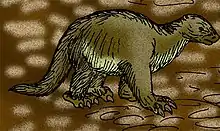 |
| Haitian pine forest sloth[4] | Neocnus dousman | Hispaniola | Most recent remains dated to 8540–1590 BCE (uncalibrated age).[2] | |
| Cuban rodent-like sloth[4] | Neocnus gliriformis | Cuba | Most recent remains dated to 5050-4050 BCE.[1] | |
| Neocnus major | Cuba[5] | Known from remains dating to either the late Pleistocene or early Holocene.[2] Possibly a synonym of N. gliriformis, with differences owing to sexual dimorphism, but this is rejected by other researchers.[4] | ||
| Haitian rak bwa sloth[4] | Neocnus toupiti | Massif de la Hotte, Haiti[4] | Most recent remains dated to 8540–1590 BCE (uncalibrated age).[2] | |
| Matthew's ground sloth[4] | Parocnus brownii | Cuba | Most recent remains dated to 3290-2730 BCE.[2] |  |
| Parocnus dominicanus | Southeastern Dominican Republic | Known from remains dating to either the late Pleistocene or early Holocene.[6] | ||
| Greater Haitian ground sloth[4] | Parocnus serus | Hispaniola, Tortuga, and Gonâve Island[4] | Most recent remains dated to 8540–1590 BCE (uncalibrated age).[2] |
Rodents (order Rodentia)
Hamsters, voles, lemmings, muskrats, and New World rats and mice (family Cricetidae)
| Common name | Scientific name | Range | Comments | Pictures |
|---|---|---|---|---|
| Barbuda giant rice rat | Megalomys audreyae | Barbuda | Most recent remains dated to 1173–1385 CE.[5] |  |
| Martinique giant rice rat | Megalomys desmarestii | Martinique | Last recorded in 1897. Presumed to have become extinct as a result of mongoose predation, or the 1902 eruption of Mount Pelée.[7] | 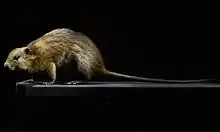 |
| Saint Lucia giant rice rat | Megalomys luciae | Saint Lucia | Last recorded before 1881. Likely extinct because of predation by introduced mongooses.[8] | 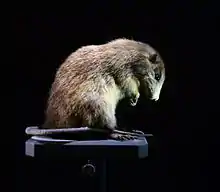 |
| Megalomys sp. | Anguilla | Extinct after European contact.[2] | ||
| Megalomys sp. | Antigua | |||
| Saint Vincent pygmy rice rat | Oligoryzomys victus | Saint Vincent | Last recorded before 1892. Probably extinct due to predation by introduced black rats, brown rats, or mongooses.[9] | |
| Jamaican rice rat | Oryzomys antillarum | Jamaica | Last recorded in 1877, five years after the introduction of mongooses.[10] |  |
| Oryzomys curasoae | Curaçao | Extinct after European contact.[2] | ||
| Oryzomys hypenemus | Antigua and Barbuda | |||
| Oryzomys sp. | Barbados | Last recorded before 1890.[2] | ||
| Oryzomys spp. | Grenada | Two different species extinct after European contact.[2] | ||
| Nevis rice rat | Pennatomys nivalis | Saint Kitts and Nevis and Sint Eustatius | Described from subfossil remains. Historical references to an "unusual-looking", edible rat from the colonial period to the 1930s may refer to this species. It likely disappeared due to predation by introduced black rats or mongooses.[11] |
Neotropical spiny rats (family Echimyidae)
| Common name | Scientific name | Range | Comments | Pictures |
|---|---|---|---|---|
| Oriente cave rat | Boromys offella | Cuba | Extinct after European contact.[2] | 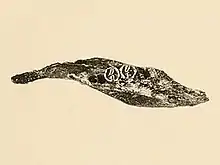 |
| Torre's cave rat | Boromys torrei | Cuba | Possibly extinct after European contact.[2] | 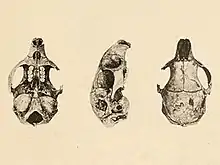 |
| Brotomys contractus | Hispaniola | |||
| Hispaniolan edible rat | Brotomys voratus | Hispaniola | Most recent remains dated to 1550-1670 CE.[2] | |
| Capromys latus | Cuba | Extinct in the late Pleistocene or early Holocene.[2] | ||
| Capromys pilorides lewisi | Grand Cayman, Cayman Brac, and Little Cayman, Cayman Islands | Most recently dated in Grand Cayman to 1439-1643 and in Cayman Brac to 1440-1624. A 1585 reference by Francis Drake to "coneys" and cat-sized "little beasts" on the islands could refer to this animal.[12] | ||
| Geocapromys caymanensis | Grand Cayman and Cayman Brac, Cayman Islands | Most recently dated at Cayman Brac to 666-857 CE.[12] | ||
| Cuban coney | Geocapromys columbianus | Cuba | Extinct after European contact.[2] | |
| Little Swan Island hutia | Geocapromys thoracatus | Little Swan Island, Honduras | Last recorded in the early 1950s. It disappeared due to predation by cats introduced around the same time, though a hurricane in 1955 may have speeded up the process.[13] | .JPG.webp) |
| Geocapromys pleistocenicus | Cuba | Extinct after European contact.[2] | ||
| Antillean cave rat | Heteropsomys antillensis | Puerto Rico | Possibly extinct after European contact.[2] | |
| Insular cave rat | Heteropsomys insulans | Puerto Rico | Most recent remains dated to 772–870 CE.[14] | |
| Imposter hutia | Hexolobodon phenax | Hispaniola | Extinct after European contact.[2] |  |
| Hexolobodon sp. | Southern Hispaniola | Possibly extinct after European contact.[2] | ||
| Montane hutia | Isolobodon montanus | Hispaniola | Extinct after European contact.[2] | |
| Puerto Rican hutia | Isolobodon portoricensis | Hispaniola and Gonâve | Remains most recently dated to 1270-1390 CE, but likely disappeared after European contact. It was domesticated to some extent by Native Americans and introduced to Puerto Rico, Mona Island, Vieques, and the Virgin Islands. Likely one of the animals mentioned by Gonzalo Fernández de Oviedo y Valdés in 1535.[2] | 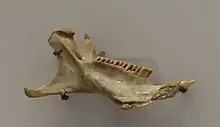 |
| Macrocapromys acevedo | Cuba | Most recent remains dated to around 450 BCE.[1] | ||
| Mesocapromys barbouri | Extinct in the late Pleistocene or early Holocene.[2] | |||
| Mesocapromys beatrizae | ||||
| Mesocapromys gracilis | ||||
| Mesocapromys kraglievichi | Most recent remains dated after around 450 BCE.[1] | |||
| Mesocapromys minimus | Extinct in the late Pleistocene or early Holocene.[2] | |||
| Plagiodontia araeum | Hispaniola | Extinct in the Holocene.[2] | ||
| Samana hutia | Plagiodontia ipnaeum | Hispaniola | Extinct after European contact.[2] | .jpg.webp) |
| Lemke's hutia | Rhizoplagiodontia lemkei | Massif de la Hotte, Haiti[4] |
Possibly extinct
| Common name | Scientific name | Range | Comments | Pictures |
|---|---|---|---|---|
| Dwarf hutia | Mesocapromys nanus | Ciénaga de Zapata, Cuba | Last collected in 1951; a nest and pellets were found in 1978. The species is threatened by introduced predators (black rat, feral dog, feral cat, mongoose), fires (sometimes set for mosquito control), and deforestation for charcoal production.[15] | |
| San Felipe hutia | Mesocapromys sanfelipensis | Key Juan García, Cuba | Last collected in 1978. It likely declined due to hunting after a military base was built on the island, fires set up by fishermen (both accidentally and for mosquito control), and predation by introduced black rats, cats, and dogs.[16] | 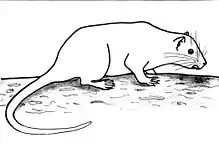 |
Giant hutias (family Heptaxodontidae)
| Common name | Scientific name | Range | Comments |
|---|---|---|---|
| Plate-toothed giant hutia | Elasmodontomys obliquus | Puerto Rico | Most recent remains dated to 511–407 BCE.[14] |
| Twisted-toothed mouse | Quemisia gravis | Hispaniola | Extinct after European contact. Although not dated, remains were found along with introduced Rattus and there are probable references to it in early colonial literature.[2] |
| Tainotherium valei | Puerto Rico | Known from an undated femur from either the late Pleistocene or early Holocene. Its morphology suggests arboreality, making unlikely that it became extinct when forests expanded in the Holocene. It might have become extinct due to human-induced habitat loss instead.[17] | |
| Diminute Jamaican hutia[4] | Xaymaca fulvopulvis | Jamaica | Most recent remains dated to 9390–8220 BCE.[2] |
Primates (order Primates)
Titis, sakis, and uakaris (family Pitheciidae)
| Common name | Scientific name | Range | Comments |
|---|---|---|---|
| Hispaniola monkey | Antillothrix bernensis | Hispaniola | Most recent remains dated to 2035–1735 BCE. Possible monkey depictions in petroglyphs, indigenous pottery and other artifacts of Cuba and Hispaniola may indicate later survival.[2] |
| La Hotte monkey | Insulacebus toussaintiana | Massif de la Hotte, Haiti[4] | Described from undated remains, but presumed to be late Holocene because of its state of conservation similar to the other species.[18] |
| Jamaican monkey | Xenothrix mcgregori | Jamaica | Most recent remains dated to 439–473 CE.[19] |
True insectivores (order Eulipotyphla)
West Indies shrews (family Nesophontidae)
| Common name | Scientific name | Range | Comments | Pictures |
|---|---|---|---|---|
| Puerto Rican nesophontes | Nesophontes edithae | Puerto Rico | Most recently dated to 1015–1147 CE[14] but believed extinct after European contact. No nesophontes species was hunted as they were too small.[2] | 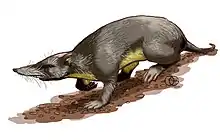 |
| Cayman nesophontes | Nesophontes hemicingulus | Grand Cayman and Cayman Brac, Cayman Islands | Most recently dated at Cayman Brac to 666–857 CE[12] but believed extinct after European contact.[2] | |
| Atalaye nesophontes | Nesophontes hypomicrus | Hispaniola | Most recently dated to 1175–1295 CE[20] but believed extinct after European contact.[2] | |
| Greater Cuban nesophontes | Nesophontes major | Cuba | Most recent remains dated to around 10 BCE at Cueva de los Nesofontes,[21] but believed extinct after European contact.[2] |  |
| Western Cuban nesophontes | Nesophontes micrus | Cuba | Most recently dated to 1310–1410 CE but believed extinct after European contact.[2] |  |
| St. Michel nesophontes | Nesophontes paramicrus | Hispaniola | Most recently dated to 1265–1400 CE[20] but believed extinct after European contact.[2] | |
| Haitian nesophontes | Nesophontes zamicrus | Hispaniola | Most recently dated to 1295–1430 CE[5] but believed extinct after European contact.[2] |
Solenodons (family Solenodontidae)
| Common name | Scientific name | Range | Comments |
|---|---|---|---|
| Giant solenodon | Solenodon arredondoi | Cuba | Extinct in the late Pleistocene or early Holocene.[2] |
| Marcano's solenodon | Solenodon marcanoi | Hispaniola | Extinct after European contact.[2] |
Bats (order Chiroptera)
Mustached, ghost-faced, and naked-backed bats (family Mormoopidae)
| Common name | Scientific name | Range | Comments |
|---|---|---|---|
| Giant ghost-faced bat | Mormoops magna | Cuba | Most recent remains dated to 7043–6503 BCE.[5] |
Locally extinct
| Common name | Scientific name | Range | Comments | Pictures |
|---|---|---|---|---|
| Ghost-faced bat | Mormoops megalophylla | Mexico to Trinidad and the Ecuadorian Andes | Most recent remains in Cuba dated near European arrival.[1] |  |
Leaf-nosed bats (family Phyllostomidae)
| Common name | Scientific name | Range | Comments | Pictures |
|---|---|---|---|---|
| Anthony's fruit-eating bat | Artibeus anthonyi | Cuba | Most recent remains dated to 1957–1993 CE.[22] |  |
| Puerto Rican long-nosed bat | Monophyllus plethodon frater | Puerto Rico | Possibly extinct between 1851 and 1900 as a result of extensive clearing for agriculture.[23] | |
| Puerto Rican flower bat | Phyllonycteris major | Puerto Rico and Antigua | Most recent remains dated to around 1500 BCE at Burma Quarry, Antigua.[24] | |
| Lesser falcate-winged bat | Phyllops vetus | Cuba and Juventud | Most recent remains dated to around 10 BCE at Cueva de los Nesofontes, Cuba.[21] |
Locally extinct
| Common name | Scientific name | Range | Comments | Pictures |
|---|---|---|---|---|
| Common vampire bat | Desmodus rotundus | From Mexico and Cuba to Uruguay | Most recent remains in Cuba dated to 1957–1993 CE.[22] |  |
Carnivorans (order Carnivora)
Earless seals (family Phocidae)
| Common name | Scientific name | Range | Comments | Pictures |
|---|---|---|---|---|
| Caribbean monk seal | Neomonachus tropicalis | Caribbean Sea, Bahamas, and Gulf of Mexico | Last recorded at Serranilla Bank in 1952. It was hunted for its skin, oil, and to remove competition for fishermen.[25] | 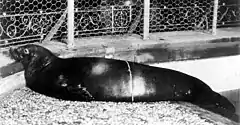 |
Birds (class Aves)
Nightjars (order Caprimulgiformes)
Typical nightjars (family Caprimulgidae)
| Common name | Scientific name | Range | Comments |
|---|---|---|---|
| Cuban pauraque | Siphonorhis daiquiri | Cuba | Most recent remains dated to 7043–6507 BCE.[5] |
Possibly extinct
| Common name | Scientific name | Range | Comments | Pictures |
|---|---|---|---|---|
| Jamaican poorwill | Siphonorhis americana | Jamaica | Last recorded in 1860. Probably extinct due to habitat destruction, predation by introduced mongooses and rats.[26] |  |
Swifts, treeswifts, and hummingbirds (order Apodiformes)
Hummingbirds (family Trochillidae)
| Common name | Scientific name | Range | Comments | Pictures |
|---|---|---|---|---|
| Brace's emerald | Riccordia bracei | New Providence, Bahamas | Only known from the holotype collected in 1877, though subfossil bones of hummingbirds found in the island probably belong to the same species. The causes of extinction are unknown but presumably human-induced.[27] |  |
| Gould's emerald | Riccordia elegans | unknown; possibly Jamaica or the northern Bahamas | Only known from the holotype collected in 1860. The reasons of extinction are unknown.[28] |  |
Pigeons and doves (order Columbiformes)
Pigeons and doves (family Columbidae)
| Common name | Scientific name | Range | Comments | Pictures |
|---|---|---|---|---|
| Puerto Rican quail-dove | Geotrygon larva | Puerto Rico | Known from subfossil remains, extinct after human settlement.[29] |  |
Rails and cranes (order Gruiformes)
Rails (family Rallidae)
| Common name | Scientific name | Range | Comments | Pictures |
|---|---|---|---|---|
| Jamaican wood rail | Amaurolimnas concolor concolor | Jamaica | Last collected in 1881. Mongoose predation has been suggested as the cause of extinction, but the species coexisted with mongooses, cats, and rats for a prolonged time.[29] | |
| Antillean cave rail | Nesotrochis debooyi | Puerto Rico | Described from subfossil remains in Pre-Columbian kitchen middens, though a 1943 report of a "flightless hen" in Virgin Gorda could have been this species.[30] It was introduced to Mona and the Virgin Islands by indigenous peoples.[3] |  |
| Cuban cave rail | Nesotrochis picapicensis | Cuba | Most recent remains dated to near European arrival.[1] | |
| Haitian cave rail | Nesotrochis steganinos | Hispaniola | Most recent remains dated to 5474-5339 BCE.[31] |
Cranes (family Gruidae)
| Common name | Scientific name | Range | Comments | Pictures |
|---|---|---|---|---|
| Cuban flightless crane | Antigone cubensis | Cuba[32] |
Shorebirds (order Charadriiformes)
Thick-knees (family Burhinidae)
| Common name | Scientific name | Range | Comments |
|---|---|---|---|
| Dwarf thick-knee | Burhinus nanus | Bahamas | 1460-1660[33] |
Sandpipers (family Scolopacidae)
| Common name | Scientific name | Range | Comments |
|---|---|---|---|
| Gallinago kakuki | Greater Antilles[32] | ||
| Hispaniola woodcock | Scolopax brachycarpa | Hispaniola | 1320–1380[34] |
Albatrosses and petrels (order Procellariiformes)
Petrels and shearwaters (family Procellariidae)
Possibly extinct
| Common name | Scientific name | Range | Comments | Pictures |
|---|---|---|---|---|
| Jamaican petrel | Pterodroma caribbaea | Jamaica; possibly Dominica, Guadeloupe, and Bahamas | Last recorded with certainty in 1880. An unconfirmed sighting was made west of Bimini, Bahamas in 1936. It was hunted with dogs in its only known breeding site, the Blue Mountains of Jamaica.[29] The extinct status is hard to ascertain as it is a nocturnal and dark-colored sea bird.[35] |  |
Storks and allies (order Ciconiiformes)
Storks (family Ciconiidae)
| Common name | Scientific name | Range | Comments | Pictures |
|---|---|---|---|---|
| Asphalt stork | Ciconia lydekkeri | Contiguous United States to Argentina[32] | ||
| Wetmore's stork | Mycteria wetmorei | Southern United States and Cuba[32] |
Pelicans, herons, and ibises (order Pelecaniformes)
Ibises and spoonbills (family Threskiornithidae)
| Common name | Scientific name | Range | Comments | Pictures |
|---|---|---|---|---|
| Jamaican ibis | Xenicibis xympithecus | Jamaica | 787 BCE – 320 CE[5] |  |
Herons (family Ardeidae)
| Common name | Scientific name | Range | Comments | Pictures |
|---|---|---|---|---|
| Bermuda night heron | Nyctanassa carcinocatactes | Bermuda | Last recorded in 1610. Likely extinct due to introduced cats, hunting, and perhaps shortage of prey.[36] |  |
Locally extinct
| Common name | Scientific name | Range | Comments | Pictures |
|---|---|---|---|---|
| Bare-throated tiger heron | Tigrisoma mexicanum | Coastal Central America and Cuba | Late Holocene[32] |  |
New World vultures (order Cathartiformes)
Teratorns (family Teratornithidae)
| Common name | Scientific name | Range | Comments |
|---|---|---|---|
| Cuban teratorn | Oscaravis olsoni | Cuba[32] |
Hawks and relatives (order Accipitriformes)
Hawks, eagles, kites, harriers and Old World vultures (family Accipitridae)
| Common name | Scientific name | Range | Comments | Pictures |
|---|---|---|---|---|
| Woodward's eagle | Amplibuteo woodwardi | California to Florida and the Caribbean[32] |  | |
| Bermuda hawk | Bermuteo avivorus | Bermuda | 1603[37] | |
| Cuban titan-hawk | Buteogallus borrasi | Cuba | Most recent remains dated to 5050-4050 BCE.[1] | |
| Suarez's giant eagle | Gigantohierax suarezi | Cuba[32] |
Locally extinct
| Common name | Scientific name | Range | Comments | Images |
|---|---|---|---|---|
| Red-shouldered hawk | Buteo lineatus | Northeastern Mexico, eastern United States and Canada, Cuba, and Bahamas | Late Holocene[32] |  |
| Black-chested buzzard-eagle | Geranoaetus melanoleucus | South America and Cuba | Late Holocene[32] | .jpg.webp) |
Owls (order Strigiformes)
True owls (family Strigidae)
| Common name | Scientific name | Range | Comments | Pictures |
|---|---|---|---|---|
| Bermuda saw-whet owl | Aegolius gradyi | Bermuda | Last recorded in 1609–1610. Likely extinct due to habitat destruction and introduced predatory mammals.[29] | |
| Antiguan burrowing owl | Athene cunicularia amaura | Antigua and Barbuda | late 19th century[38] | |
| Guadeloupe burrowing owl | Athene cunicularia guadeloupensis | Guadeloupe | late 19th century[38] | |
| Cuban horned owl | Bubo osvaldoi | Cuba[32] | ||
| Cuban cursorial owl | Ornimegalonyx oteroi | Cuba | Most recent remains dated to 5050-4050 BCE.[1] | 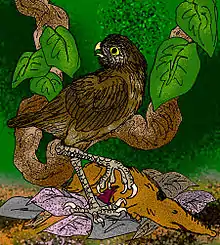 |
| Cuban spectacled owl | Pulsatrix arredondoi | Cuba | 530–590[32] |
Possibly extinct
| Common name | Scientific name | Range | Comments | Pictures |
|---|---|---|---|---|
| Virgin Islands screech owl | Gymnasio nudipes newtoni | Virgin Islands | Last confirmed record in 1936 in Saint Croix, with an unconfirmed one on Guana Island in 1985. Likely extinct due to forest clearance for agriculture.[29] |  |
Barn-owls (family Tytonidae)
| Common name | Scientific name | Range | Comments | Pictures |
|---|---|---|---|---|
| Puerto Rican barn owl | Tyto cavatica | Puerto Rico | Described from subfossil remains. 1912 reports of cave-nesting owls may refer to this species.[29] |  |
| Noel's barn owl | Tyto noeli | Cuba, Jamaica, and Barbuda | 1900–1600 BCE[32] Extinct due to deforestation, invasive animals, and loss of prey.[29] | |
| Hispaniolan giant barn owl | Tyto ostologa | Haiti and southern Dominican Republic | A 1788 description of a call and feathers at Pic la Selle may refer to this species. There was also an unconfirmed sighting in the 1970s.[29] | |
| Bahaman giant barn owl | Tyto pollens | Cuba and Bahamas | Described from subfossil remains but may have survived until the 16th century.[29] |  |
Falcons (order Falconiformes)
Falcons and caracaras (family Falconidae)
| Common name | Scientific name | Range | Comments | Pictures |
|---|---|---|---|---|
| Bahaman caracara | Caracara creightoni | Cuba and Bahamas | 700–400 BCE[39] |  |
| Cuban kestrel | Falco kurochkini | Cuba[32] | ||
| Cuban caracara | Milvago carbo | Cuba[32] |
Locally extinct
| Common name | Scientific name | Range | Comments | Pictures |
|---|---|---|---|---|
| Aplomado falcon | Falco femoralis | New Mexico to Patagonia | Late Holocene[32] |  |
Woodpeckers and allies (order Piciformes)
Woodpeckers (family Picidae)
| Common name | Scientific name | Range | Comments | Pictures |
|---|---|---|---|---|
| Cuban ivory-billed woodpecker | Campephilus principalis bairdii | Cuba | 1987[40] |  |
| Bermuda flicker | Colaptes oceanicus | Bermuda | Last recorded in 1623; the decimation of local birds by feral cats was also noted.[41] |
Parrots (order Psittaciformes)
Holotropical parrots (family Psittacidae)
| Common name | Scientific name | Range | Comments | Pictures |
|---|---|---|---|---|
| Aruba amazon | Amazona barbadensis canifrons | Aruba | 1944–1947[29] | 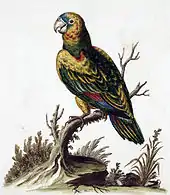 |
| Martinique amazon | Amazona martinicana | Martinique | 1779[42] |  |
| Guadeloupe amazon | Amazona violacea | Guadeloupe | 1779[43] |  |
| Culebra Island amazon | Amazona vittata gracilipes | Culebra Island of Puerto Rico | 1899[29] | |
| Amazona sp. | Antigua | Most recent remains dated to around 1500 BCE at Burma Quarry, Antigua.[24] | ||
| St. Croix macaw | Ara autocthones | Puerto Rico and Saint Croix | Known from pre-Columbian subfossil remains.[3] |  |
| Lesser Antillean macaw | Ara guadeloupensis | Guadeloupe | 1742[29] | 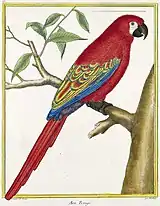 |
| Martinique macaw | Ara martinicus | Martinique | 17th century | |
| Cuban macaw | Ara tricolor | Cuba and Juventud | 1889[29] |  |
| Guadeloupe parakeet | Psittacara labati | Guadeloupe | 1724[29] |  |
| Puerto Rican parakeet | Psittacara maugei | Puerto Rico and Mona Island | 1892[29] |  |
Perching birds (order Passeriformes)
Chat-tanagers (family Calyptophilidae)
| Common name | Scientific name | Range | Comments |
|---|---|---|---|
| Gonâve eastern chat-tanager | Calyptophilus frugivorus abbotti | Gonâve Island, Haiti | 1977[29] |
| Samaná eastern chat-tanager | Calyptophilus frugivorus frugivorus | Samaná Peninsula, Dominican Republic | 1982[29] |
Tanagers (family Thraupidae)
Possibly extinct
| Common name | Scientific name | Range | Comments | Pictures |
|---|---|---|---|---|
| St. Kitts bullfinch | Melopyrrha grandis | Saint Kitts | 1929[29] |  |
Swallows (family Hirundinidae)
| Common name | Scientific name | Range | Comments | Pictures |
|---|---|---|---|---|
| Jamaican golden swallow | Tachycineta euchrysea euchrysea | Jamaica | 1989[29] | 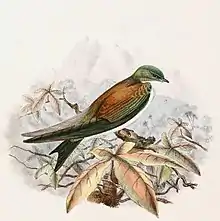 |
New World blackbirds (family Icteridae)
| Common name | Scientific name | Range | Comments |
|---|---|---|---|
| Grand Cayman oriole | Icterus leucopteryx bairdi | Grand Cayman, Cayman Islands | 1938[29] |
New World sparrows (family Passerellidae)
| Common name | Scientific name | Range | Comments |
|---|---|---|---|
| Bermuda towhee | Pipilio naufragus | Bermuda | 1609–1610[29] |
Wrens (family Troglodytidae)
| Common name | Scientific name | Range | Comments |
|---|---|---|---|
| Guadeloupe house wren | Troglodytes aedon guadeloupensis | Guadeloupe | 1973[29] |
| Martinique house wren | Troglodytes aedon martinicensis | Martinique | 1886[29] |
Thrushes (family Turdidae)
| Common name | Scientific name | Range | Comments |
|---|---|---|---|
| Grand Cayman thrush | Turdus ravidus | 1938[44] | Grand Cayman, Cayman Islands |
New World warblers (family Parulidae)
Possibly extinct
| Common name | Scientific name | Range | Comments | Pictures |
|---|---|---|---|---|
| Semper's warbler | Leucopeza semperi | Saint Lucia mountains | 1961[45] |  |
| Bachman's warbler | Vermivora bachmanii | Southeastern United States and Cuba | 1988[46] | 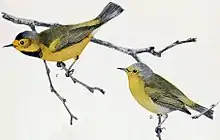 |
Reptiles (class Reptilia)
Crocodilians (order Crocodilia)
Crocodiles (family Crocodylidae)
Locally extinct
| Common name | Scientific name | Range | Comments | Pictures |
|---|---|---|---|---|
| Cuban crocodile | Crocodylus rhombifer | Bahamas, Cuba, Hispaniola, and the Cayman Islands; possibly also Jamaica | Most recent remains in Hispaniola dated to 5480-5370 BCE,[47] the Abaco Islands to 1730-830 BCE,[48] Crooked Island to 1300-1400 CE,[49] and the Caymans to 1030-1585 CE. Historical references to crocodiles on Grand Cayman in 1774 and "alligators" on Great Inagua, Bahamas in 1886 likely refer to this species. Only survives in the Zapata Swamp of southern Cuba and the Lanier Swamp of Juventud.[48] |  |
Squamates (order Squamata)
Whiptails (family Teiidae)
| Common name | Scientific name | Range | Comments |
|---|---|---|---|
| Guadeloupe ameiva | Pholidoscelis cineraceus | Guadeloupe | Last recorded in 1914. Likely extinct due to hunting and introduced predators.[50] |
Possibly extinct
| Common name | Scientific name | Range | Comments | Pictures |
|---|---|---|---|---|
| Martinique giant ameiva | Pholidoscelis major | Petite Terre Islands off Guadeloupe | Last collected before 1825. The causes of extinction are unknown.[51] |  |
Curly-tailed lizards (family Leiocephalidae)
| Common name | Scientific name | Range | Comments | Pictures |
|---|---|---|---|---|
| Leeward Islands curlytail | Leiocephalus cuneus | Antigua and Barbuda | Most recent remains dated to around 1500 BCE at Burma Quarry, Antigua.[24] | |
| Navassa curly-tailed lizard | Leiocephalus eremitus | Navassa Island | 19th century[52] | |
| Martinique curlytail lizard | Leiocephalus herminieri | Martinique | 1837[53] |  |
Galliwasps (family Diploglossidae)
Possibly extinct
| Common name | Scientific name | Range | Comments | Pictures |
|---|---|---|---|---|
| Jamaica giant galliwasp | Celestus occiduus | Jamaica | 1851[54] |  |
Iguanas and chuckwallas (family Iguanidae)
| Common name | Scientific name | Range | Comments |
|---|---|---|---|
| Navassa Island iguana | Cyclura cornuta onchiopsis | Navassa Island | 1878[55] |
Anoles (family Dactyloidae)
Possibly extinct
| Common name | Scientific name | Range | Comments |
|---|---|---|---|
| Virgin Islands giant anole | Anolis roosevelti | Vieques, Culebra, Saint John, and Tortola | 1932[56] |
Boas (family Boidae)
| Scientific name | Range | Comments |
|---|---|---|
| cf. Boidae | Antigua | Most recent remains dated to around 1500 BCE at Burma Quarry, Antigua.[24] |
Colubrids (family Colubridae)
| Common name | Scientific name | Range | Comments |
|---|---|---|---|
| Saint Croix racer | Borikenophis sanctaecrucis | Saint Croix, U.S. Virgin Islands | c. 1900[57] |
Dwarf boas (family Tropidophiidae)
| Common name | Scientific name | Range | Comments |
|---|---|---|---|
| Navassa Island dwarf boa | Tropidophis bucculentus | Navassa Island | late 19th century[58] |
Turtles and tortoises (order Testudines)
Tortoises (family Testudinidae)
| Common name | Scientific name | Range | Comments |
|---|---|---|---|
| Abaco tortoise[59] | Chelonoidis alburyorum | Abaco Islands, Bahamas | Most recent remains dated to around 1170 AD.[60] |
| Cuban giant tortoise[59] | Chelonoidis cubensis | Cuba | Most recent remains dated to 5050-4050 BCE.[1] |
| Chelonoidis gersoni | Hispaniola | Known from remains from the late Pleistocene or early Holocene.[61] | |
| Chelonoidis marcanoi | |||
| Mona tortoise | Chelonoidis monensis | Mona Island of Puerto Rico | Most recent remains dated to around 1050 BCE.[59] |
| Caicos giant tortoise | Chelonoidis sp. | Middle Caicos | Most recent remains dated to around 1400 CE.[59] |
| Turks tortoise | Chelonoidis sp. | Grand Turk Island | Most recent remains dated to around 1200 CE.[59] |
Amphibians (class Amphibia)
Frogs (order Anura)
Rain frogs (family Eleutherodactylidae)
Possibly extinct
| Common name | Scientific name | Range | Comments | Pictures |
|---|---|---|---|---|
| Golden coquí | Eleutherodactylus jasperi | Sierra de Cayey, Puerto Rico | Last recorded in 1981. Probably declined due to chytridiomycosis and less likely to predation by introduced black rats.[62] |  |
| Web-footed coquí | Eleutherodactylus karlschmidti | Puerto Rican mountains | Last recorded in 1976. The causes of extinction are unknown, though most specimens collected and preserved in the 1960s were later found to have suffered from chytridiomycosis. Predation by small Indian mongooses and black rats is also possible.[63] |
Insects (class Insecta)
Butterflies (order Lepidoptera)
Swallowtail butterflies (family Papilionidae)
| Scientific name | Range | Comments | Pictures |
|---|---|---|---|
| Battus polydamas antiquus | Antigua | Only known from a painting made in 1770.[24] | 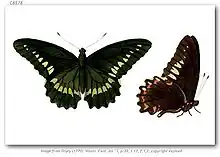 |
Family Uraniidae
| Common name | Scientific name | Range | Comments | Pictures |
|---|---|---|---|---|
| Sloane's Urania butterfly | Urania sloanus | Jamaica lowlands | Last collected in 1908.[64] | 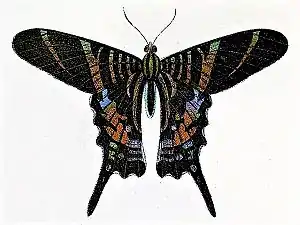 |
Arachnids (class Arachnida)
Order Mesostigmata
Family Halarachnidae
| Common name | Scientific name | Range | Comments | Pictures |
|---|---|---|---|---|
| Caribbean monk seal nasal mite | Halarachne americana | Caribbean Sea | Extinct with its host.[65] | .jpg.webp) |
Scorpions (order Scorpiones)
Family Buthidae
| Scientific name | Range | Comments | Pictures |
|---|---|---|---|
| Tityus exstinctus | Northern range of Martinique | Only known from the holotype collected in 1884. Possibly disappeared due to human activity or the Mount Pelée eruption in 1902.[66] |  |
Slugs and snails (class Gastropoda)
Family Neocyclotidae
| Scientific name | Range |
|---|---|
| Amphicyclotulus guadeloupensis | Guadeloupe[67] |
| Incerticyclus cinereus | Martinique[68] |
| Incerticyclus martinicensis | Martinique[69] |
Family Oleacinidae
| Scientific name | Range |
|---|---|
| Oleacina guadeloupensis | Guadeloupe[70] |
Family Pleurodontidae
| Scientific name | Range | Comments |
|---|---|---|
| Pleurodonte desidens | Martinique | Not recorded since its description in 1834.[71] |
See also
References
- 1 2 3 4 5 6 7 8 9 10 Orihuela, J., Viñola, L. W., Vázquez, O. J., Mychajliw, A. M., de Lara, O. H., Lorenzo, L., & Soto-Centeno, J. A. (2020). Assessing the role of humans in Greater Antillean land vertebrate extinctions: New insights from Cuba. Quaternary Science Reviews, 249, 106597.
- 1 2 3 4 5 6 7 8 9 10 11 12 13 14 15 16 17 18 19 20 21 22 23 24 25 26 27 28 29 30 31 32 33 34 35 36 37 38 39 40 41 MacPhee, R. D. E. (2009). Insulae infortunatae: establishing a chronology for Late Quaternary mammal extinctions in the West Indies. In American megafaunal extinctions at the end of the Pleistocene (pp. 169–193). Springer, Dordrecht.
- 1 2 3 Olson, S. L., & López, E. J. M. (2008). New evidence of Ara autochthones from an archeological site in Puerto Rico: a valid species of West Indian macaw of unknown geographical origin (Aves: Psittacidae). Caribbean Journal of Science, 44(2), 215-222.
- 1 2 3 4 5 6 7 8 9 10 11 12 13 14 15 16 17 Borroto-Páez, R., Mancina, C. A., Woods, C. A., & Kilpatrick, C. W. (2012) Updated checklist of endemic terrestrial mammals of the West Indies. In: Borroto-Páez, R., Woods, C.A., Sergile, F.E. (eds) Terrestrial mammals of the West Indies: Contributions. Wacahoota Press/ University of Vermont, Burlington.
- 1 2 3 4 5 6 7 Turvey, Sam (2009). Holocene extinctions. Oxford University Press. ISBN 978-0-19-953509-5. Retrieved 29 February 2012.
- ↑ McAfee, R., Beery, S., Rimoli, R., Almonte, J., Lehman, P., & Cooke, S. (2021). New species of the ground sloth Parocnus from the late Pleistocene-early Holocene of Hispaniola. Vertebrate Anatomy, Morphology, Palaeontology, 9(1).
- ↑ Turvey, S.T.; Helgen, K. (2017). "Megalomys desmarestii". IUCN Red List of Threatened Species. 2017: e.T12980A22377057. doi:10.2305/IUCN.UK.2017-3.RLTS.T12980A22377057.en. Retrieved 8 August 2021.
- ↑ Turvey, S.T.; Helgen, K. (2017). "Megalomys luciae". IUCN Red List of Threatened Species. 2017: e.T12981A22377126. doi:10.2305/IUCN.UK.2017-3.RLTS.T12981A22377126.en. Retrieved 8 August 2021.
- ↑ Turvey, S.T.; Dávalos, L. (2019). "Oligoryzomys victus". IUCN Red List of Threatened Species. 2019: e.T15255A22357957. doi:10.2305/IUCN.UK.2019-1.RLTS.T15255A22357957.en. Retrieved 8 August 2021.
- ↑ Turvey, S.T.; Helgen, K. (2017). "Oryzomys antillarum". IUCN Red List of Threatened Species. 2017: e.T136540A22388029. doi:10.2305/IUCN.UK.2017-3.RLTS.T136540A22388029.en. Retrieved 18 November 2021.
- ↑ Turvey, S.T.; Collen, B. (2011). "Pennatomys nivalis". IUCN Red List of Threatened Species. 2011: e.T199838A9129524. doi:10.2305/IUCN.UK.2011-2.RLTS.T199838A9129524.en. Retrieved 8 August 2021.
- 1 2 3 Morgan, Gary S., et al. "Late Quaternary fossil mammals from the Cayman Islands, West Indies." Bulletin of the American Museum of Natural History 2019.428 (2019): 1–82.
- ↑ Turvey, S.T.; Helgen, K. (2018). "Geocapromys thoracatus". IUCN Red List of Threatened Species. 2018: e.T9003A22186735. doi:10.2305/IUCN.UK.2018-2.RLTS.T9003A22186735.en. Retrieved 8 August 2021.
- 1 2 3 Turvey, S.T; Oliver, J.R; Storde, Y.M Narganes; Rye, P (22 April 2007). "Late Holocene extinction of Puerto Rican native land mammals". Biology Letters. 3 (2): 193–6. doi:10.1098/rsbl.2006.0585. PMC 2375922. PMID 17251123.
- ↑ Young, R.; Kennerley, R.; Turvey, S.T.; Borotto-Páez, R. (2020) [amended version of 2018 assessment]. "Mesocapromys nanus". IUCN Red List of Threatened Species. 2020: e.T13217A166518354. doi:10.2305/IUCN.UK.2020-1.RLTS.T13217A166518354.en. Retrieved 8 August 2021.
- ↑ Kennerley, R.; Turvey, S.T.; Young, R.; Borotto-Páez, R. (2019). "Mesocapromys sanfelipensis". IUCN Red List of Threatened Species. 2019: e.T13218A22186444. doi:10.2305/IUCN.UK.2019-1.RLTS.T13218A22186444.en. Retrieved 8 August 2021.
- ↑ Turvey, S. T., Grady, F. V., & Rye, P. (2006). A new genus and species of ‘giant hutia’(Tainotherium valei) from the Quaternary of Puerto Rico: an extinct arboreal quadruped?. Journal of Zoology, 270(4), 585-594.
- ↑ Cooke, S. B., Rosenberger, A. L., & Turvey, S. (2011). An extinct monkey from Haiti and the origins of the Greater Antillean primates. Proceedings of the National Academy of Sciences, 108(7), 2699–2704.
- ↑ Cooke, S. B., Mychajliw, A. M., Southon, J., & MacPhee, R. D. (2017). The extinction of Xenothrix mcgregori, Jamaica's last monkey. Journal of Mammalogy, 98(4), 937–949.
- 1 2 MacPhee, Ross DE, Clare Flemming, and Darrin P. Lunde. ""Last occurrence" of the Antillean insectivoran Nesophontes: new radiometric dates and their interpretation. American Museum novitates; no. 3261." (1999).
- 1 2 Orihuela, J., Orozco, L. P., Licourt, J. L. Á., Muñoz, R. A. V., & Barani, C. S. (2020). Late Holocene land vertebrate fauna from Cueva de los Nesofontes, Western Cuba: stratigraphy, last appearance dates, diversity and paleoecology. bioRxiv.
- 1 2 Orihuela, J. (2010). Late Holocene fauna from a cave deposit in Western Cuba: post-Columbian occurrence of the vampire bat Desmodus rotundus (Phyllostomidae: Desmodontinae). Caribbean Journal of Science, 46(2–3), 297–312.
- ↑ Westermann, J.H. (1953) Nature preservation in the Caribbean: A review of literature of the destruction and preservation of flora and fauna in the Caribbean area. Foundation for Scientific Research in Surinam and the Netherlands Antilles, 106 pages.
- 1 2 3 4 5 Steadman, D. W., Pregill, G. K., & Olson, S. L. (1984). Fossil vertebrates from Antigua, Lesser Antilles: evidence for late Holocene human-caused extinctions in the West Indies. Proceedings of the National Academy of Sciences, 81(14), 4448–4451.
- ↑ Lowry, L. (2015). "Neomonachus tropicalis". IUCN Red List of Threatened Species. 2015: e.T13655A45228171. doi:10.2305/IUCN.UK.2015-2.RLTS.T13655A45228171.en. Retrieved 8 August 2021.
- ↑ BirdLife International. (2020). "Siphonorhis americana". IUCN Red List of Threatened Species. 2020: e.T22689738A178420953. doi:10.2305/IUCN.UK.2020-3.RLTS.T22689738A178420953.en. Retrieved 8 August 2021.
- ↑ BirdLife International (2016). "Chlorostilbon bracei". IUCN Red List of Threatened Species. 2016: e.T22687333A93148138. doi:10.2305/IUCN.UK.2016-3.RLTS.T22687333A93148138.en. Retrieved 18 November 2021.
- ↑ BirdLife International (2016). "Chlorostilbon elegans". IUCN Red List of Threatened Species. 2016: e.T22728709A94994346. doi:10.2305/IUCN.UK.2016-3.RLTS.T22728709A94994346.en. Retrieved 18 November 2021.
- 1 2 3 4 5 6 7 8 9 10 11 12 13 14 15 16 17 18 19 20 21 22 23 Hume, J.P. (2017) Extinct Birds. Bloomsbury Publishing, 560 pages.
- ↑ Olson, S. L. (1974). A new species of Nesotrochis from Hispaniola, with notes on other fossil rails from the West Indies (Aves: Rallidae). Proceedings of the Biological Society of Washington.
- ↑ Oswald, J. A., Terrill, R. S., Stucky, B. J., LeFebvre, M. J., Steadman, D. W., Guralnick, R. P., & Allen, J. M. (2021). Ancient DNA from the extinct Haitian cave-rail (Nesotrochis steganinos) suggests a biogeographic connection between the Caribbean and Old World. Biology letters, 17(3), 20200760.
- 1 2 3 4 5 6 7 8 9 10 11 12 13 14 15 16 Orihuela, J. (2019). An annotated list of Late Quaternary extinct birds of Cuba. Ornitología Neotropical, 30, 57–67.
- ↑ Oswald, J. A., & Steadman, D. W. (2018). The late Quaternary bird community of New Providence, Bahamas. The Auk: Ornithological Advances, 135(2), 359–377.
- ↑ Steadman, D. W., & Takano, O. M. (2013). A late-Holocene bird community from Hispaniola: refining the chronology of vertebrate extinction in the West Indies. The Holocene, 23(7), 936–944.
- ↑ BirdLife International (2018). "Pterodroma caribbaea". IUCN Red List of Threatened Species. 2018: e.T22698097A132625182. doi:10.2305/IUCN.UK.2018-2.RLTS.T22698097A132625182.en. Retrieved 19 November 2021.
- ↑ BirdLife International (2017). "Nyctanassa carcinocatactes". IUCN Red List of Threatened Species. 2017: e.T62286255A119207935. doi:10.2305/IUCN.UK.2017-3.RLTS.T62286255A119207935.en. Retrieved 13 January 2018.
- ↑ BirdLife International (2017). "Bermuteo avivorus". IUCN Red List of Threatened Species. 2017: e.T62183030A119208276. doi:10.2305/IUCN.UK.2017-3.RLTS.T62183030A119208276.en. Retrieved 13 November 2021.
- 1 2 BirdLife International. (2016). Athene cunicularia. The IUCN Red List of Threatened Species 2016. doi:10.2305/IUCN.UK.2016-3.RLTS.T22689353A93227732.en
- ↑ Oswald, J. A., Allen, J. M., Witt, K. E., Folk, R. A., Albury, N. A., Steadman, D. W., & Guralnick, R. P. (2019). Ancient DNA from a 2,500-year-old Caribbean fossil places an extinct bird (Caracara creightoni) in a phylogenetic context. Molecular phylogenetics and evolution, 140, 106576.
- ↑ BirdLife International (2020). "Campephilus principalis". IUCN Red List of Threatened Species. 2020: e.T22681425A182588014. Retrieved 24 December 2020.
- ↑ Quote In: Lefroy, J. H. (1981). Memorials of the discovery and early settlement of the Bermudas or Somers Islands 1515–1685. Second reprinting, volume 1. Bermuda Historical Society, Hamilton, p. 330
- ↑ BirdLife International (2016). "Amazona martinicana". IUCN Red List of Threatened Species. 2016: e.T22728705A94994181. doi:10.2305/IUCN.UK.2016-3.RLTS.T22728705A94994181.en. Retrieved 18 November 2021.
- ↑ BirdLife International (2016). "Amazona violacea". IUCN Red List of Threatened Species. 2016: e.T22728701A94994037. doi:10.2305/IUCN.UK.2016-3.RLTS.T22728701A94994037.en. Retrieved 18 November 2021.
- ↑ BirdLife International (2018). "Turdus ravidus". IUCN Red List of Threatened Species. 2018: e.T22708835A129654803. doi:10.2305/IUCN.UK.2018-2.RLTS.T22708835A129654803.en. Retrieved 18 November 2021.
- ↑ BirdLife International (2020). "Leucopeza semperi". IUCN Red List of Threatened Species. 2020: e.T22721873A180049729. doi:10.2305/IUCN.UK.2020-3.RLTS.T22721873A180049729.en. Retrieved 18 November 2021.
- ↑ "Bachman's Warbler". South Florida Multi-species Recovery Plan (PDF). US Fish and Wildlife Service, Southeast Region. 1999. pp. 445–454.
- ↑ Morgan, G. S., Albury, N. A., Rímoli, R., Lehman, P., Rosenberger, A. L., & Cooke, S. B. (2018). The Cuban crocodile (Crocodylus rhombifer) from Late Quaternary underwater cave deposits in the Dominican Republic. American Museum Novitates, 2018(3916), 1-56.
- 1 2 Morgan, G. S., & Albury, N. A. (2013). The Cuban crocodile (Crocodylus rhombifer) from late Quaternary fossil deposits in the Bahamas and Cayman Islands (pp. 161-236). University of Florida.
- ↑ Steadman, D. W., Singleton, H. M., Delancy, K. M., Albury, N. A., Soto-Centeno, J. A., Gough, H., ... & Keegan, W. F. (2017). Late Holocene historical ecology: The timing of vertebrate extirpation on Crooked Island, Commonwealth of The Bahamas. The Journal of Island and Coastal Archaeology, 12(4), 572-584.
- ↑ Dewynter, M. (2017) [amended version of 2016 assessment]. "Pholidoscelis cineraceus". IUCN Red List of Threatened Species. 2017: e.T1119A121639617. doi:10.2305/IUCN.UK.2017-3.RLTS.T1119A121639617.en. Retrieved 8 August 2021.
- ↑ Dewynter, M.; Powell, R. (2017). "Pholidoscelis major". IUCN Red List of Threatened Species. 2017: e.T1120A121642128. doi:10.2305/IUCN.UK.2017-3.RLTS.T1120A121642128.en. Retrieved 11 November 2021.
- ↑ Inchaustegui, S.; Landestoy, M.; Powell, R. (2017) [errata version of 2016 assessment]. "Leiocephalus eremitus". IUCN Red List of Threatened Species. 2016: e.T11388A115102107. doi:10.2305/IUCN.UK.2016-3.RLTS.T11388A71739619.en. Retrieved 8 August 2021.
- ↑ Powell, R. (2017) [errata version of 2016 assessment]. "Leiocephalus herminieri". IUCN Red List of Threatened Species. 2016: e.T11389A115102240. doi:10.2305/IUCN.UK.2016-3.RLTS.T11389A71739645.en. Retrieved 8 August 2021.
- ↑ Wilson, B.S.; Hedges, B. (2020) [amended version of 2017 assessment]. "Celestus occiduus". IUCN Red List of Threatened Species. 2020: e.T4097A181348221. doi:10.2305/IUCN.UK.2020-3.RLTS.T4097A181348221.en. Retrieved 8 August 2021.
- ↑ Powell, R. (2011). "Cyclura onchiopsis". IUCN Red List of Threatened Species. 2011: e.T173001A6955940. doi:10.2305/IUCN.UK.2011-1.RLTS.T173001A6955940.en. Retrieved 8 August 2021.
- ↑ Platenberg, R.; de Queiroz, K.; Mahler, D.L. (2020). "Anolis roosevelti". IUCN Red List of Threatened Species. 2020: e.T1319A18967413. doi:10.2305/IUCN.UK.2020-3.RLTS.T1319A18967413.en. Retrieved 18 November 2021.
- ↑ Platenberg, R.; Powell, R. (2017) [errata version of 2016 assessment]. "Borikenophis sanctaecrucis". IUCN Red List of Threatened Species. 2016: e.T40791A115177079. doi:10.2305/IUCN.UK.2016-3.RLTS.T40791A71740001.en. Retrieved 8 August 2021.
- ↑ Landestoy, M.; Inchaustegui, S.; Powell, R.; Henderson, R.W. (2021). "Tropidophis bucculentus". IUCN Red List of Threatened Species. 2021: e.T75606372A75607979. doi:10.2305/IUCN.UK.2021-2.RLTS.T75606372A75607979.en. Retrieved 13 May 2022.
- 1 2 3 4 5 Conservation Biology of Freshwater Turtles and Tortoises: A Compilation Project of the IUCN/SSC Tortoise and Freshwater Turtle Specialist Group. A.G.J. Rhodin, P.C.H. Pritchard, P.P. van Dijk, R.A. Saumure, K.A. Buhlmann, J.B. Iverson, and R.A. Mittermeier, Eds. Chelonian Research Monographs (ISSN 1088-7105) No. 5, doi:10.3854/crm.5.000e.fossil.checklist.v1.2015
- ↑ Kehlmaier, C., Barlow, A., Hastings, A. K., Vamberger, M., Paijmans, J. L., Steadman, D. W., ... & Fritz, U. (2017). Tropical ancient DNA reveals relationships of the extinct Bahamian giant tortoise Chelonoidis alburyorum. Proceedings of the Royal Society B: Biological Sciences, 284(1846), 20162235.
- ↑ Viñola-López, L. W., & Almonte, J. N. (2022). Revision of the fossil land tortoises (Testudines: Testudinidae) from Hispaniola with the description of a new species. Novitates Caribaea, (20), 11-29.
- ↑ IUCN SSC Amphibian Specialist Group. (2021). "Eleutherodactylus jasperi". IUCN Red List of Threatened Species. 2021: e.T7142A172793582. doi:10.2305/IUCN.UK.2021-1.RLTS.T7142A172793582.en. Retrieved 8 August 2021.
- ↑ IUCN SSC Amphibian Specialist Group. (2021). "Eleutherodactylus karlschmidti". IUCN Red List of Threatened Species. 2021: e.T7146A172793731. doi:10.2305/IUCN.UK.2021-1.RLTS.T7146A172793731.en. Retrieved 8 August 2021.
- ↑ Vinciguerra, R. (2009). Osservazioni su Urania sloanus (Cramer, 1779)(Lepidoptera: Uraniidae). SHILAP Revista de Lepidopterología, 37(147), 307-311.
- ↑ Seal, West Indian Monk. Published 13 July 2004 by the American Society of Mammalogists.
- ↑ Lourenço, W. R. (1995). The remarkable discovery of a new and extinct species of Tityus from Martinique in Lesser Antilles (Chelicerata, Scorpiones, Buthidae). Anales de la Universidad Nacional Autónoma de México, Serie Zoológica, 66(1), 27–32.
- ↑ Bouchet, P. (1996). "Amphicyclotulus guadeloupensis". IUCN Red List of Threatened Species. 1996: e.T1164A3300027. doi:10.2305/IUCN.UK.1996.RLTS.T1164A3300027.en. Retrieved 13 November 2021.
- ↑ Bouchet, P. (1996). "Incerticyclus cinereus". IUCN Red List of Threatened Species. 1996: e.T10815A3218955. doi:10.2305/IUCN.UK.1996.RLTS.T10815A3218955.en. Retrieved 13 November 2021.
- ↑ Bouchet, P. (1996). "Incerticyclus cinereus". IUCN Red List of Threatened Species. 1996: e.T10815A3218955. doi:10.2305/IUCN.UK.1996.RLTS.T10815A3218955.en. Retrieved 13 November 2021.
- ↑ Bouchet, P. (1996). "Oleacina guadeloupensis". IUCN Red List of Threatened Species. 1996: e.T15191A4501196. doi:10.2305/IUCN.UK.1996.RLTS.T15191A4501196.en. Retrieved 13 November 2021.
- ↑ Bouchet, P. (2000). "Pleurodonte desidens". IUCN Red List of Threatened Species. 2000: e.T17708A7352120. doi:10.2305/IUCN.UK.2000.RLTS.T17708A7352120.en. Retrieved 13 November 2021.